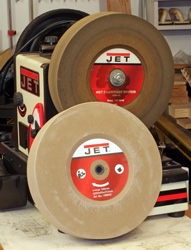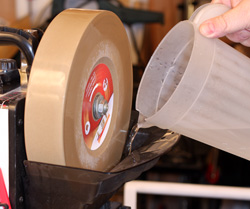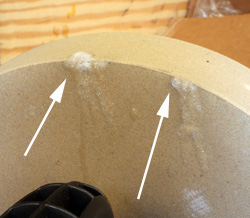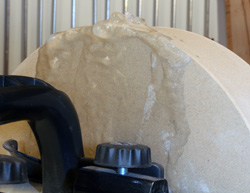This is a Veteran Owned site
![]()
 |
A very calm email asked if I knew for sure that leaving a wet (with water) grinding stone in freezing temperatures will actually break it. Good point, and one I am now investigating with a brand new JET stone grinding wheel! Click image to enlarge |
Water + Stone Grinding Wheel + Freezing Temperatures
A lone, level-headed email got me thinking- again
Text, photos and video by Tom Hintz
Posted – 1-22-2011
When I posted my story about using antifreeze in my JET Wet Grinder it drew lots of interest and the expected admonitions from a few incensed non-believers who suspected conspiracy at every turn. Then, one person emailed me asking if I knew for sure that plain water would break at stone wheel in below freezing temperatures. Ah, nope.
I had not actually seen one break, had not had one break in my shop or talked directly to anyone who had one break strictly because of freezing. So, that one, decidedly non-hysterical email inspired this [expensive] story.
The Insanity
Since I have been saturating the original stone wheel on my JET Wet Sharpener in the antifreeze solution every other day or so for the last month (to see if antifreeze turned it to porridge, it isn’t) trying to saturate it with plain water now was not going to work. So, as dumb as it sounds, I am going to fully saturate a brand new JET stone grinding wheel with plain water and let the frigid side of Mother Nature have her way with it. This new stone wheel is identical to the one I have been using for the last few years except that the new one has not been used and has not been treated with antifreeze.
Not So Insane
For this test I replaced the now antifreeze-laden stone wheel on my JET Wet Sharpener with the brand new, unused, non-antifreeze treated one just as it came from its box. I went through the entire saturation procedure several times during the first day to be sure that the stone actually was fully saturated through and through.
 |
 |
To prepare the new JET stone wheel (left) I saturated it several times with plain water to be sure that it was soaked all of the way through as per the directions. Despite basking in temperatures in the low 20's on the first night it didn't break. However, it did grow a couple icicles (right) that at least confirm that it was cold in there! Stay tuned! Click images to enlarge |
|
Then I removed the water tank and emptied that because I don’t have a spare…. Then I left the JET Wet Sharpener to fend for itself in the unheated shop, standing next to the open vent in my garage door to be sure it is exposed to outside temperatures. In the previous antifreeze test I placed a thermometer literally leaning against the stone wheel and noted that the indoor temperature at the door vent was within 2-degrees of the outside temperature. Close enough for me and inside is way more secure as well.
Day (night) 1
The evening before I removed the water tank, shut down the shop (no heat was on all day) and let the stone drip dry. I was up again at 2 am and started monitoring the temperature at the stone with it parked directly in front of the vent in my garage door. I kept peeking in to see the temperature and it went from 29-degrees when I first got up to a low of 23-degrees and stayed within a degree or two of that temperature for about five hours when the outside temperatures began rising.
I felt the JET Wet Sharpener wheel and though it was very cold to the touch, I could find no cracks, breaks or chips. Then as I turned the wheel to look at the bottom edge I found something unexpected – icicles. Not big long ones but icicles nonetheless. I carefully looked all around the icicles and noted that there was no apparent damage to the stone wheel.
So, we know that the wheel sat in freezing temperatures with that corroborated by the thermometer and the icicles. While water is obviously freezing on the outside of the wheel I really have no way of telling for sure if it is freezing INSIDE of the stone. The only way I know for sure is to keep on leaving it in the freezing temperatures and hope that we get a very cold night. I watched the local weather and colder temperatures seems like a sure thing in the coming days. Stay tuned!
Day 2 - 18-Degrees!
 |
Day two of the freeze test shows lot of the plain water frozen all over the side of the JET stone wheel but again, no cracks anywhere to be found! Click image to enlarge |
For day two of this test I decided to fully saturate the JET stone wheel with plain water again, remove the water tank, let the stone drip for maybe 5 minutes and then placed it outside of the door directly in 18-degree cold. I left it there until 7:30AM when the temperature rocketed up to 19-degrees. Keep in mind that before starting this test the JET stone wheel had been in my shop at a balmy 40-degrees so it was not heated up or anything. It was cold when it went into the cold and just got colder for a bit more than 5 hours.
As you can see in the photo, it has grown a much bigger icicle along with a large, rough textured sheet of ice covering much of what was the lower half of the wheel when it was outside. But, no evidence of cracks. Nothing, I can't find anything wrong with the JET stone wheel other than it looks very odd with lots of ice growing out of it.
I am hoping that we get some colder weather soon so I can continue this test. It makes no sense to me that this JET stone wheel will not crack when frozen. So far it sure is looking like the JET stone grinding wheel isn't nearly as freeze-fragile as I thought. But, stay tuned!
This story will be updated often or until I can reach some conclusion.
Have a comment on this story? Email Me!
All written, photographic and drawn materials are property of and copyright by NewWoodworker.com LLC 2000-2019. Materials may not be used in any way without the written permission of the owner.
